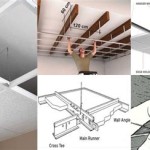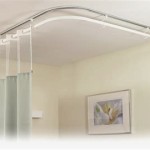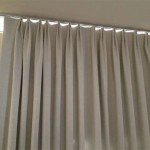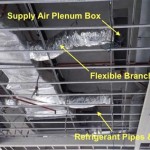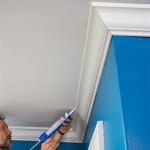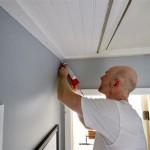Heating Ducts in Ceiling: A Comprehensive Overview
Heating ducts play a vital role in maintaining a comfortable indoor environment, especially in regions with significant temperature variations. Installing these ducts within the ceiling presents a common and often advantageous approach to distributing heated air throughout a building. The following article provides a detailed examination of heating ducts located in ceilings, encompassing their advantages, disadvantages, installation considerations, maintenance requirements, and potential issues.
The fundamental purpose of heating ducts is to transport heated air from a central heating unit, such as a furnace or heat pump, to various rooms within a building. This distribution network allows for the efficient and consistent heating of the entire structure, ensuring a comfortable environment regardless of external weather conditions. The design and implementation of these duct systems are crucial for optimizing energy efficiency and minimizing heat loss during the distribution process.
Locating heating ducts in the ceiling offers several distinct benefits. Primarily, it leverages the natural tendency of warm air to rise. By distributing heated air from above, the system assists in maintaining a more uniform temperature throughout the room. This is because warm air, introduced at the ceiling level, will gradually descend, displacing cooler air and creating a more even temperature gradient. This approach is particularly effective in rooms with high ceilings where temperature stratification can be a significant issue.
Furthermore, ceiling-based ductwork can minimize the visual impact of the heating system. Unlike ductwork that runs along walls or floors, ceiling ducts can be concealed above a suspended ceiling or within the building's structural framework. This integration results in a cleaner, more aesthetically pleasing interior, as the ductwork remains largely invisible. This is a significant advantage for homeowners and building managers who prioritize the aesthetic appearance of their spaces.
From a practical standpoint, ceiling ductwork can also simplify the process of furniture placement and interior design. With ducts concealed overhead, there are fewer obstructions hindering the arrangement of furniture or the installation of wall coverings. This flexibility allows for greater freedom in designing the interior layout without being constrained by the presence of visible ductwork.
Advantages of Ceiling-Based Heating Ducts
The adoption of heating ducts within the ceiling offers various advantages that cater to efficiency, aesthetics, and practicality. These benefits make it a preferred option for many residential and commercial properties.
One key advantage is enhanced temperature distribution. Warm air naturally rises, and by positioning the ducts in the ceiling, the system utilizes this natural phenomenon to its advantage. The heated air is released at the highest point in the room, promoting even distribution as it gradually descends and mixes with the cooler air below. This helps to eliminate cold spots and maintain a consistent temperature throughout the space. This is especially important in rooms with high ceilings or large open areas where temperature disparities can be more pronounced.
Aesthetic appeal is another significant benefit of ceiling-based ductwork. By concealing the ducts above a suspended ceiling or within the building structure, the system becomes virtually invisible. This creates a cleaner and more uncluttered interior appearance. This advantage is particularly valuable in spaces where aesthetics are a priority, such as living rooms, offices, and retail spaces. The hidden ductwork allows for a more streamlined and visually appealing environment.
Space optimization is improved with ceiling-mounted ducts. Unlike ductwork that runs along walls or floors, ceiling ducts do not obstruct furniture placement or limit interior design options. This provides greater flexibility in arranging furniture and designing the layout of the room without being constrained by the presence of visible ducts. This is especially beneficial in smaller spaces where maximizing usable area is crucial.
Improved air quality can be indirectly affected by ceiling-based systems. By keeping the ductwork out of reach and potentially less exposed to dust and debris accumulation, the air circulating through the system may be cleaner. Proper sealing and insulation of the ductwork also helps to prevent the introduction of contaminants into the air stream. Regular maintenance and filter replacement are still essential to ensure optimal air quality, but the location of the ducts can contribute to a cleaner overall system.
Disadvantages and Challenges of Ceiling-Based Heating Ducts
While ceiling-based heating ducts offer numerous advantages, there are also certain disadvantages and challenges to consider before installation. These potential drawbacks can impact the overall efficiency and cost-effectiveness of the system.
One primary concern is accessibility for maintenance and repairs. When ducts are concealed within the ceiling, accessing them for inspection, cleaning, or repairs can be significantly more difficult compared to ducts that are exposed or located in more accessible areas. This can increase the cost of maintenance and repairs, as specialized tools and expertise may be required to reach the ductwork. The disruption caused by accessing the ceiling space can also be a major inconvenience.
Insulation is another critical factor to consider. Ducts located in unconditioned ceiling spaces, such as attics or crawl spaces, are susceptible to heat loss or gain. Inadequate insulation can reduce the efficiency of the heating system, leading to higher energy bills. Proper insulation of the ductwork is essential to minimize heat transfer and maintain the desired temperature of the air flowing through the ducts. The type and thickness of insulation should be carefully selected to meet local building codes and climate conditions.
Installation costs can be higher than for other ductwork configurations. Running ducts within the ceiling requires more intricate planning and labor compared to exposed ductwork. The need to work around existing structural elements and the added complexity of concealing the ducts can increase the overall cost of installation. Proper sealing and insulation also add to the expense. Homeowners and building managers should factor these costs into their budget when considering ceiling-based ductwork.
Potential for leaks can be a significant problem. If ductwork is not properly sealed, air leaks can occur, resulting in heat loss and reduced efficiency. Leaks can also introduce contaminants into the air stream, negatively impacting air quality. Regularly inspecting the ductwork for leaks and sealing any cracks or gaps is crucial to maintain optimal performance. The use of high-quality sealing materials and proper installation techniques are essential to prevent leaks from occurring.
Noise transmission is another consideration. Ducts can transmit noise from the heating unit to different rooms in the building. To minimize noise transmission, the ductwork should be properly insulated and isolated from the building structure. Flexible duct connectors can also be used to dampen vibrations and reduce noise levels. Attention to these details can help create a quieter and more comfortable indoor environment.
Installation and Maintenance Considerations
Proper installation and regular maintenance are crucial for ensuring the long-term efficiency and performance of ceiling-based heating ducts. Careful planning and execution during the installation phase can prevent costly problems down the road, while routine maintenance helps to keep the system operating at its optimal level.
During installation, it is essential to select the appropriate ductwork materials and sizes. The ductwork should be sized according to the heating load requirements of each room to ensure adequate airflow and temperature distribution. The materials used should be durable, resistant to corrosion, and suitable for use in the specific environment. Flexible ductwork can be used in some areas to navigate around obstacles, but rigid ductwork is generally preferred for straight runs to minimize air resistance.
Proper sealing of the ductwork is critical to prevent air leaks. All joints and seams should be sealed with high-quality duct tape or mastic to ensure an airtight connection. The sealing process should be thorough and meticulous to minimize air loss and maintain energy efficiency. Regular inspections should be conducted to identify and seal any leaks that may develop over time.
Insulation is another essential aspect of installation. Ducts located in unconditioned spaces should be properly insulated to minimize heat loss or gain. The insulation should be applied evenly and completely cover the ductwork. The type and thickness of insulation should be selected based on local climate conditions and building codes. Regularly inspect the insulation for damage or deterioration and replace it as needed.
Maintenance should be performed regularly to keep the system operating efficiently. This includes cleaning the ducts to remove dust, dirt, and debris that can accumulate over time. Dirty ducts can reduce airflow and negatively impact air quality. Professional duct cleaning services can be used to thoroughly clean the entire ductwork system. Air filters should also be replaced regularly to prevent dust and debris from entering the ductwork.
Regular inspections should be conducted to identify any signs of damage or deterioration. This includes checking for leaks, corrosion, and insulation damage. Any problems should be addressed promptly to prevent further damage and maintain optimal performance. Professional HVAC technicians can provide comprehensive inspections and maintenance services to ensure the system is operating safely and efficiently.
Proper installation and maintenance are key to maximizing the benefits of ceiling-based heating ducts and minimizing potential problems. By following these guidelines, homeowners and building managers can ensure that their heating system operates efficiently, effectively, and safely for years to come.

How Do You Clean Heating Ducts In The Ceiling Duct Masters
Hvac Talk Heating Air Refrigeration Discussion

The Benefits Of Using Ceiling Hvac Vents

Ducts In Dropped Ceilings Building America Solution Center

Hvac Ductwork Air Duct Types Working Problems Installation Austin Area Conditioning And Heating G S Mechanical

Best Practices Of Hvac Duct Installation

How To Get Your Ducts Inside The Building Enclosure Greenbuildingadvisor

Hvac Exposed 20 Ideas For Daring Ductwork

Ceiling Ac Vents Pros And Cons Aire Serv

Signs Your Ducts Aren T Sealed Properly Elmers Home Services
Related Posts

